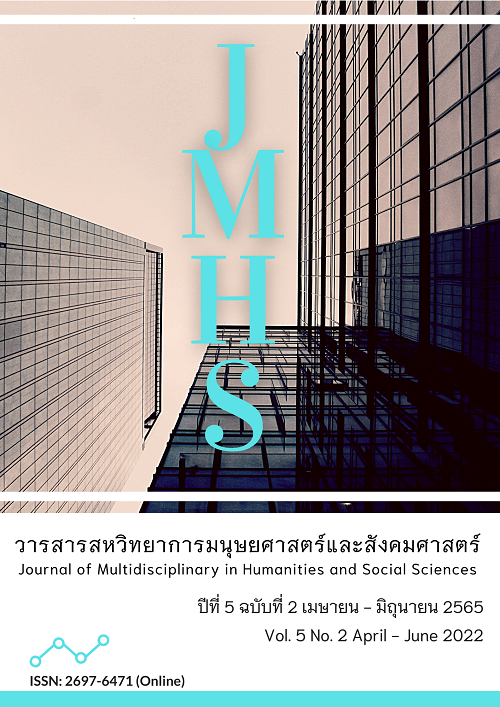A Study of Insight Meditation Practice in Ariyavamsa Sutta
Main Article Content
Abstract
The objectives of this article were 1) to study the content and Buddhist teaching in Ariyavamsa Sutta; 2) to study the practice of Vipassana meditation in Theravada Buddhist scriptures; and 3) to analyze the practice of Vipassana meditation in Ariyavamsa Sutta. This was qualitative research by studying data from Theravada Buddhist scriptures, and documents related, summarized, analyzed, compile in descriptive style. The results of the research an analysis of Vipassana practice in Ariyavamsa Sutta was divided into 4 themes: (1) in Cīvarasantuṭṭha, the practitioner should satisfy cloth received, Bhikkhus should know his own robe, robe’s place, left robes, own robe satisfying, and disciplines related to the robe, 2) in Piṇḍapatasantuṭṭha, Bhikkhus should rejoice in alms giving, they are, food as received, knowing arm giving, arm giving place, satisfaction in one own giving, and disciplines related to arm giving, 3) in Senāsanasantuṭṭha or contentment on monastery, Bhikkhus should be contented in the seclusion, that is, knowing the area of dwelling, dwelling’s area, dwelling contentment, and disciplines related to dwellings, there will be no greed and worry, which lead practice of Vipassana meditation to progress well, 4) in Pahānabhāvanārāmatā, Bhikkhus should be contented in the meditation and abandonment, that is , one would develop 4 efforts, 4 success, 5 faculties, 5 powers, 7 factors of enlightenment, 7 observations, 18 great insights, 37 factors leading to enlightenment as the 4th Noble lineage. This practice is considered as the ultimate goal in Buddhism.
Article Details

This work is licensed under a Creative Commons Attribution-NonCommercial-NoDerivatives 4.0 International License.
Views and opinions appearing in the Journal it is the responsibility of the author of the article, and does not constitute the view and responsibility of the editorial team.
References
ชัยชาญ ศรีหานู. (2564). วิเคราะห์คำสอนวิปัสสนาในเตภูมิกถาที่มีผลต่อคตินิยมเชิงพุทธในสังคมไทย. วารสาร มจร บาฬีศึกษาพุทธโฆสปริทรรศน์, 7(1), 12-26.
พระธรรมกิตติวงศ์ (ทองดี สุรเตโช), (2550). พจนานุกรมเพื่อการศึกษาพุทธศาสน์ ชุดศัพท์วิเคราะห์.กรุงเทพฯ: โรงพิมพ์เลี่ยงเชียง.
พระธรรมธีรราชมหามุนี (โชดก ญาณสิทฺธิ). (2532). มงคล 38. กรุงเทพฯ: การพิมพ์พระนคร.
พระพรหมคุณาภรณ์ (ป.อ. ปยุตฺโต). (2553). พจนานุกรมพุทธศาสตร์ ฉบับประมวลธรรม. (พิมพ์ครั้งที่ 18). กรุงเทพฯ: โรงพิมพ์มหาจุฬาลงกรณราชวิทยาลัย
พระพุทธโฆสเถระ. (2554). คัมภีร์วิสุทธิมรรค. (สมเด็จพระพุฒาจารย์ อาจ อาสภมหาเถร), แปล).(พิมพ์ครั้งที่ 10). กรุงเทพฯ: ธนาเพรส.
พระมหาวีรยุทธ กุสลจิตฺโต และ พระมหามิตร ฐิตปญฺโญ. (2564). สันโดษ คือ องค์ธรรมแห่งการรู้จักพอ. Journal of Buddhist Education and Research, 7(1), 276-288.
พระมหาสมปอง มุทิโต. (2542). คัมภีร์อภิธานวรรณา. กรุงเทพฯ: ธรรมสภา.
พระสมชาย บัวแก้ว, พระมหาบุญศรี วงค์แก้ว และ สุเชาวน์ พลอยชุม. (2564). อภิสมาจาร: กระบวนการพัฒนาบุคลิกภาพตามแนวพระพุทธศาสนา. วารสารศิลปการจัดการ, 5(3), 895-907.
พระสิริมังคลเถระ. (2554). มังคลัตถทีปนี ภาษาไทย ภาค 1. กรุงเทพฯ. โรงพิมพ์มหาจุฬาลงกรณราชวิทยาลัย.
พระโสภณมหาเถระ (มหาสีสยาดอ). (2548). วิปัสสนานัย เล่ม 1. (พระคันธสาราภิวงศ์, แปล). นครปฐม: ซีเอไอ เซ็นเตอร์.
มหาจุฬาลงกรณราชวิทยาลัย. (2539). พระไตรปิฎกภาษาไทย ฉบับมหาจุฬาลงกรณราชวิทยาลัย. กรุงเทพฯ: โรงพิมพ์มหาจุฬาลงกรณราชวิทยาลัย.
มหาจุฬาลงกรณราชวิทยาลัย. (2552). อรรถกถาภาษาไทย ฉบับมหาจุฬาลงกรณราชวิทยาลัย. กรุงเทพฯ: โรงพิมพ์มหาจุฬาลงกรณราชวิทยาลัย.
สมเด็จพระญาณสังวร (เจริญ สุวฑฺฒโน). (2533). สันโดษ. กรุงเทพฯ: อมรินทร์ปริ้นติ้งกรุ๊ป.
สมเด็จพระพุทธชินวงศ์ (สมศักดิ์ อุปสมมหาเถระ). (2554). อริยวังสปฏิปทา ปฏิปทาอันเป็นวงศ์แห่งพระอริยะ. กรุงเทพฯ: ประยูรสาส์นไทยการพิมพ์.
อรชร ไกรจักร์, เเม่ชีกฤษณา รักษาโฉม และ พระมหาวรัญธรณ์ ญาณกิตฺติ. (2564). บุคลิกภาพของพระภิกษุตามหลักเวสารัชชกรณธรรม. วารสาร มจร บาฬีศึกษาพุทธโฆสปริทรรศน์, 7(3), 113-125.
Tan, C. C., & Damnoen, P. S. (2020). Buddhist Noble Eightfold Path Approach in the Study of Consumer and Organizational Behaviors. Journal of MCU Peace Studies, 8(1), 1-20.


